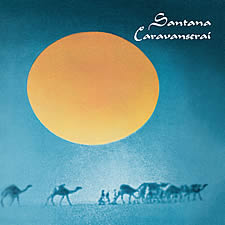|
"With Caravanserai, we wanted to make some sort of statement about
what we were trying to do, where we were trying to go" Michael Shrieve 5/03
In some respects the death knell for the band Santana had already
been sounded by the time Caravanserai was recorded during the summer of
1972. Notwithstanding the fact that the band was enjoying a worldwide
popularity that had translated into record sales in the millions for 1969's
Santana and its follow-ups Abraxas and Santana III, the schism which
revolved around the direction the band would take and under whose
leadership continued to widen. Songs such as Evil Ways, Black Magic
Woman/Gypsy Queen, Oye Como Va, Samba Pa Ti, and Jingo had already
established an unparalleled identity for this band and it only remained for
them to produce more of the same to further cement and broaden their
enormous public appeal. But yet, Carlos Santana found himself becoming
increasingly less enamored not only with the content of the band's music
but also with the quality of his life. The excesses and heady lifestyles
that came with fame and fortune were threatening to destroy him, he began
to realize, and the music, for all its obvious merit and attendant public
acceptance no longer excited him.
|
|
|
|
|

|





